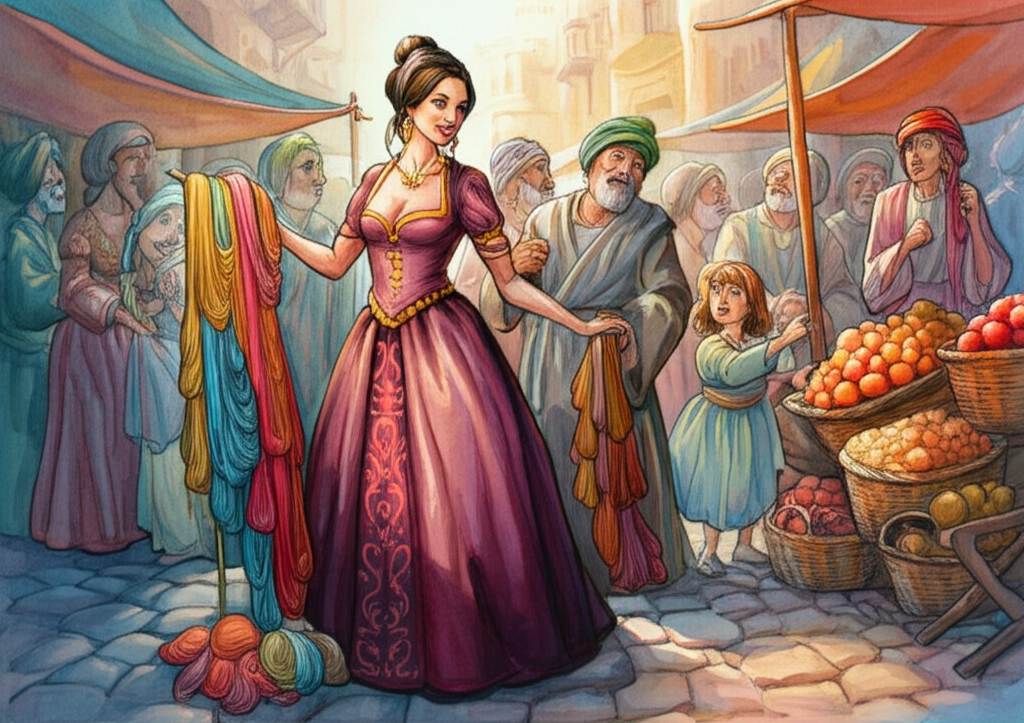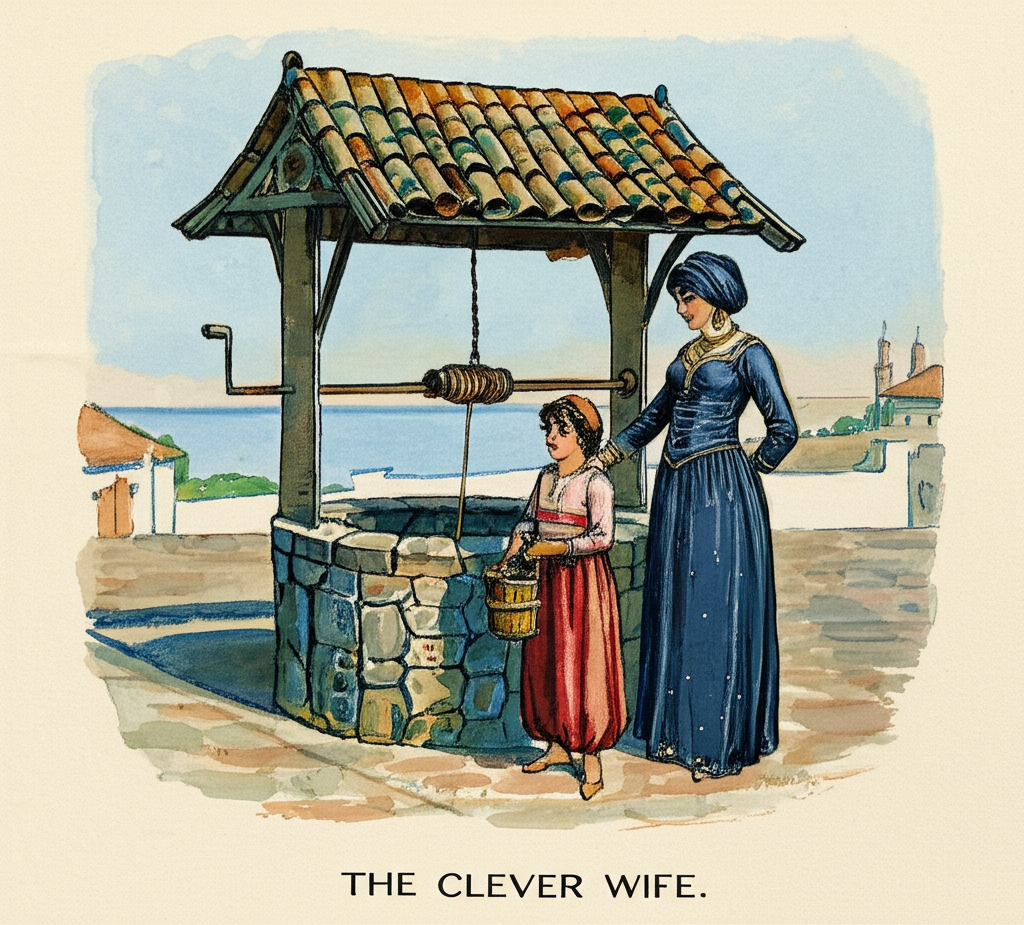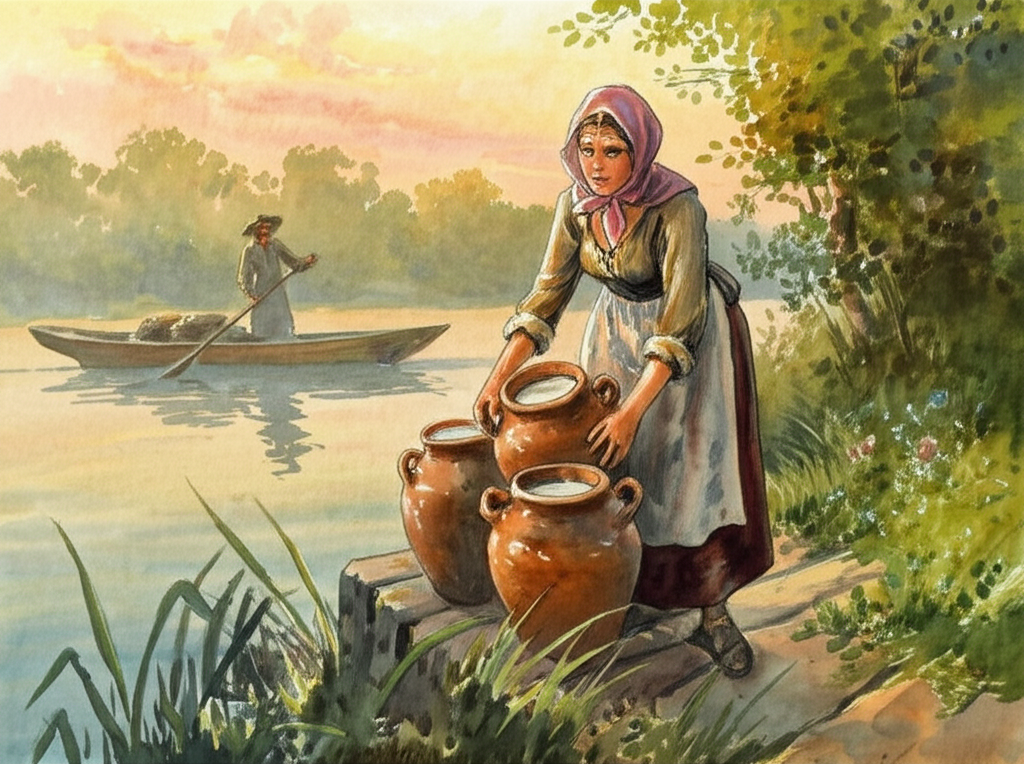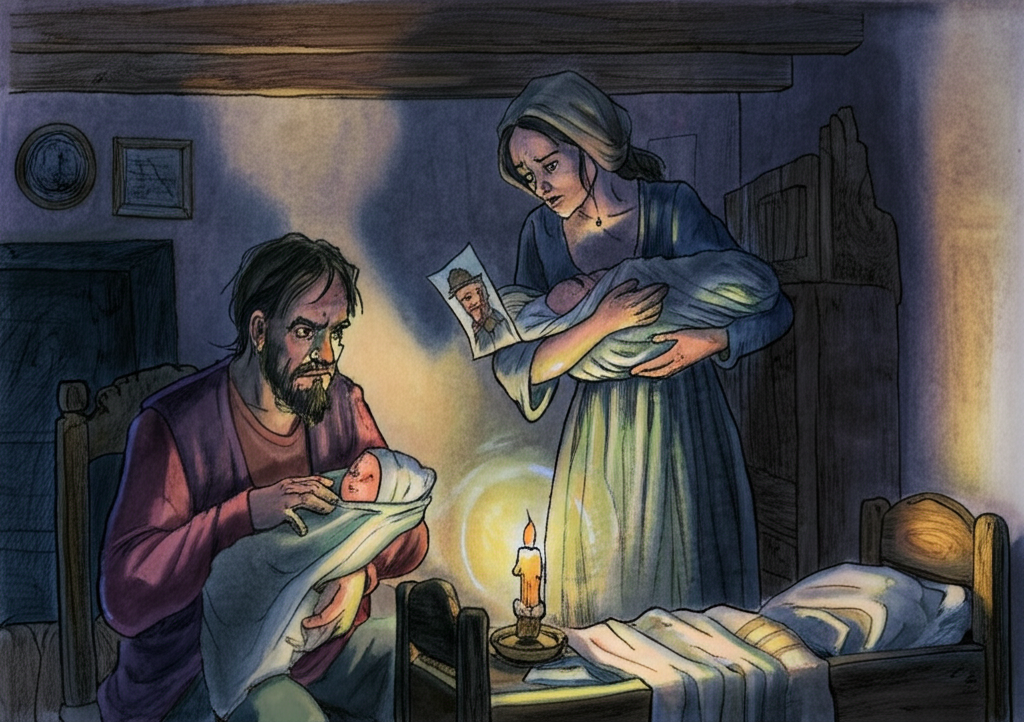Once upon a time, in a land far away, lived a merchant who loved to travel. He would sail his boat to different countries to buy and sell cool stuff. One day, he told his wife, “I have to go on a trip for a whole year!” He chuckled and added, “When I get back, I hope you’ve built a super awesome well for me. And since you’re so smart, I also hope to see a little baby boy!” Then he hopped on his boat and waved goodbye.

As soon as he was gone, his wife got to work. She spun four bundles of amazing, colorful string all by herself. Then, she put on her fanciest outfit and sparkly jewelry. “I’m going to the market!” she told her helpers, “I’m going to sell this string.” One of the helpers said, “That’s not a good idea! You shouldn’t sell it yourself. Let me do it. What will your husband say if he finds out you were selling string at the market?” But the merchant’s wife said, “I want to sell it myself! You could never sell it for as much as I can!”

So, she went to the market. Everyone who saw her thought she was so pretty! Finally, the town guard saw her and came right up to her.
“Wow, that’s beautiful string!” he said. “Are you selling it?” “Yes,” she said. “How much for one bundle?” asked the guard. “Fifty rupees!” she answered. “Fifty rupees! Who would pay that much?” “I won’t sell it for less,” she said. “I’ll get fifty rupees for it!” “Okay,” said the guard, “I’ll give you fifty rupees. Can I come over for dinner at your house?” “Yes,” she answered, “Tonight at ten o’clock!” Then he took the string and gave her the money.
Next, she went to another part of the market, and the king’s advisor saw her trying to sell her string. “What beautiful string! Is it for sale?” he asked. “Yes, for one hundred rupees a bundle!” she answered. “Okay, I’ll give you one hundred rupees. Can I come to your house for dinner?” said the advisor. “Yes,” she answered, “Tonight at eleven o’clock!” “Great!” said the advisor. “Here’s the money!” And he took the string and left.
The merchant’s wife then went to a third part of the market, where the king’s judge saw her. “Is that beautiful string for sale?” he asked. “Yes,” she answered, “for one hundred and fifty rupees!” “I’ll give you the money. Can I come to your house for dinner?” “Yes,” she said, “Tonight at twelve o’clock!” “I’ll be there!” said the judge. “Here are one hundred and fifty rupees!” So, she took the money and gave him the string.
With her fourth bundle, she went to the last part of the market, where the king’s palace was. The king saw her and asked if the string was for sale. “Yes,” she said, “for five hundred rupees!” “Give me the string,” said the king. “Here’s your five hundred rupees. Can I come to your house for dinner?” “Yes,” she said, “Tonight at two o’clock!”
Then she went home and told one of her helpers to buy her four big boxes. She told her other helpers to make four yummy dinners for her. Each dinner had to be in a different room. One had to be ready at ten o’clock, one at eleven, one at twelve, and one at two in the morning. The helper brought her four big boxes, and she put them in four different rooms.

At ten o’clock, the town guard arrived. The merchant’s wife greeted him with a smile, and they sat down and ate dinner. After dinner, she said, “Do you want to play cards?” “Yes,” he answered. She got some cards, and they played until the clock struck eleven. Then, the doorkeeper came in and said, “The king’s advisor is here and wants to see you!” The town guard was super scared. “Hide me somewhere!” he said to her. “I don’t have anywhere to hide you in this room,” she answered, “but I have a big box in another room. I can lock you in there if you want, and when the advisor is gone, I’ll let you out.” So, she took him to the next room, and he climbed into one of the four big boxes. She shut the lid and locked it.
Then, she told the doorkeeper to bring in the advisor, and they ate dinner together. After dinner, she said, “Do you want to play cards?” “Yes,” said the advisor. She got the cards, and they played until twelve o’clock. Then, the doorkeeper came and said the king’s judge had come to see her. “Oh no, hide me! Hide me!” cried the advisor, very scared. “If you come to another room,” she said, “I’ll hide you in a big box. I can let you out when he’s gone.” So, she locked the advisor up in the second box.
She and the judge now ate dinner. Then, she said, “Do you want to play cards?” “Yes,” said the judge. So, they played cards until two o’clock, when the doorkeeper said the king had come to see her. “Oh, what am I going to do?” said the judge, terribly frightened. “Hide me! Don’t let the king see me!” “You can hide in a big box I have in another room, if you want,” she answered, “until he’s gone.” And she locked the judge in her third box.
The king now came in, and they ate dinner. “Do you want to play a game of cards?” she asked. “Yes,” said the king. So, they played until three o’clock, when the doorkeeper came running in (just like she told him to) and said, “Your husband’s boat has arrived! He’s coming up to the house! He’ll be here any minute!” “Now what am I going to do?” said the king, who was just as scared as the others had been. “Here comes your husband! He can’t see me! You have to hide me somewhere!” “I don’t have anywhere to hide you,” she said, “except for a big box. You can get in there if you want, and I’ll let you out tomorrow morning.” So, she shut the lid of the fourth box down on the king and locked him up. Then she went to bed and fell asleep until morning.
The next day, after she had taken a bath, gotten dressed, eaten breakfast, and done her chores, she said to her helpers, “I need four strong people!” So, the helpers went to find them. When they came, she showed them the four boxes and said, “Each of you has to take one of these boxes on your head and come with me!” Then they left with her, each carrying a box.
Meanwhile, the town guard’s son, the advisor’s son, the judge’s son, and the king’s son had been running around looking everywhere for their fathers. They asked everyone if they had seen them, but no one knew anything about them.
The merchant’s wife went first to the town guard’s house, and there she saw his son. She had the guard’s box put down on the ground in front of his door. “Do you want to buy this box?” she said to his son. “What’s inside?” he asked. “Something very special!” she answered. “How much do you want for it?” said his son. “One thousand rupees,” she said, “and when you open the box, you’ll see it’s worth two thousand. But don’t open it until you’re in your father’s house!” “Okay,” said the guard’s son. “Here’s a thousand rupees!” The woman and the other three boxes went on their way, while he took his into the house. “This box is heavy!” he said. “What could be inside?” Then he lifted the lid. “Oh no, it’s my father!” he cried. “Father, how did you get in this box?” The town guard was very embarrassed. “I never thought she would trick me like that!” he said, and then he had to tell his son the whole story.
The merchant’s wife next stopped at the advisor’s house, and there she saw his son. The advisor’s box was put down in front of his door, and she said to his son, “Do you want to buy this box?” “What’s inside of it?” he asked. “Something very special!” she answered. “Will you buy it?” “How much do you want for it?” asked the son. “Only two thousand rupees, and it’s worth three thousand!” So, the advisor’s son bought his father, without knowing it, for two thousand rupees. “Don’t open the box until you’re in the house!” said the merchant’s wife. The advisor’s son opened the box in the house right away, wondering what could be in it. The advisor’s wife was standing there the whole time. When they saw the advisor himself, looking very embarrassed, they were super surprised. “How did you get in there?” they cried. “Where have you been?” said his wife. “Oh,” said the advisor, “I never thought she would treat me like this!” And he, too, had to tell the whole story.
Now the merchant’s wife stopped at the judge’s door, and there stood the judge’s son. “Do you want to buy this box?” she said to him, and had the judge’s box put on the ground. “What’s in it?” said the judge’s son. “Silver and gold!” she answered. “You can have it for three thousand rupees. The contents are worth four!” “Okay, I’ll take it,” said the son. “Don’t open it until you’re in your house!” she said, and took her three thousand rupees and went away. There was lots of excitement when the judge stepped out of the box. “Oh!” he groaned, “I never thought she could do this to me!”
The merchant’s wife now went to the palace, and set the king’s box down at the palace gates. There she saw the king’s son. “Do you want to buy this box?” she said. “What’s in it?” asked the prince. “Diamonds, pearls, and all kinds of shiny stones!” said the merchant’s wife. “You can have the box for five thousand rupees, but its contents are worth much more!” “Okay,” said the king’s son, “here are your five thousand rupees! Give me the box!” “Don’t open it out here,” she said. “Take it into the palace and open it there!” And away she went home.
The king’s son opened the box, and there was his father! “What is going on here?” cried the prince. “How did you get in the box?” The king was very embarrassed and didn’t say much about his adventure. But when he was sitting in his courtroom, he had the merchant’s wife brought to him and gave her lots of rupees, saying, “You are a wise and clever woman!”
Now, the town guard knew the advisor had gone to see the merchant’s wife, the advisor knew the judge had gone, and the judge knew the king had gone. But that was all they knew.
The merchant’s wife now had plenty of rupees, so she built a super beautiful well with a roof over it. Then she locked the door of the well and told the helpers that no one could drink the water or take a bath in it until her husband came home. He had to be the first one to drink the water and bathe in the well.

Then, she sent her helper to the market to buy her clothes and jewelry like the ones that farm girls wear. When the helper brought them, she packed them up in a box. Then, she dressed up in boy’s clothes so that no one could tell she was a woman, and told them to get a horse ready for her. “I’m going to travel to another land for a little while,” she said. “You all have to take good care of the house while I’m gone!” The helpers didn’t want her to go. They were afraid her husband might come back while she was gone and be mad at them for letting her leave. “Don’t be scared,” she said. “Everything will be okay. I’ll come back!”
So, she left, taking the key to the well, the box with the farm girl clothes, and plenty of rupees. She also took two of her helpers. She traveled a long, long way, asking everyone about her husband’s boat. Finally, after a month, she found it. She rented a little house and dressed up like a farm girl. Then she got some yummy milk and went to the river to sell it. Everyone said, “Look at that beautiful girl selling milk!” She sold her milk super quickly because it was so good. She did this for several days, until her husband, the merchant, saw her. He thought she was so pretty that he asked her to bring him some milk to his boat. So, every day for a little while, she sold him milk. One day, he said to her, “Will you marry me?” “How can I marry you?” she said. “You’re a merchant, and I’m a farm girl. Soon, you’ll be leaving this country and sailing to another one in your boat. You’ll want me to go with you. Then I’ll have to leave my mom and dad, and who will take care of them?” “Let’s get married,” said the merchant. “I’m staying here for three months. When I leave, you can go back to your parents, and later I’ll come back to you.” She agreed, and they got married, and she went to live in the boat. At the end of three months, the merchant said to her, “My work here is done, and I have to go to another country. Would you like to go home to your parents while I’m away?” “Yes,” she said. “Here are some rupees for you to live on while I’m gone,” he said. “I don’t want any rupees,” said his wife. “I just want you to give me two things: your old hat and your picture.” He gave them to her, and then he went to his boat, and she went back to her own home.

Later, she had a little baby boy. The helpers were very scared because they thought their master would be angry when he came home. And he was angry when he came back two months later. He was so upset that he wouldn’t even look at the baby boy, and he barely looked at his beautiful well.
One night, he was lying awake thinking. He even thought about hurting his wife and her baby boy. But the next day, she came to him. “Tell me the truth,” she said. “Are you mad at me? Don’t be angry, because I want to show you a picture I like very much. It’s a picture of my boy’s father!” Then she showed him his own picture and the old hat he had given her on his boat. She told him how she had been the farm girl and also how she had earned the money to build his well. “See,” she said, “I did everything you asked me to. Here is your well, and here is your son!” Then the merchant was very happy. He kissed and loved his little son and thought his well was beautiful. He said to his wife, “You’re such a smart woman!”
